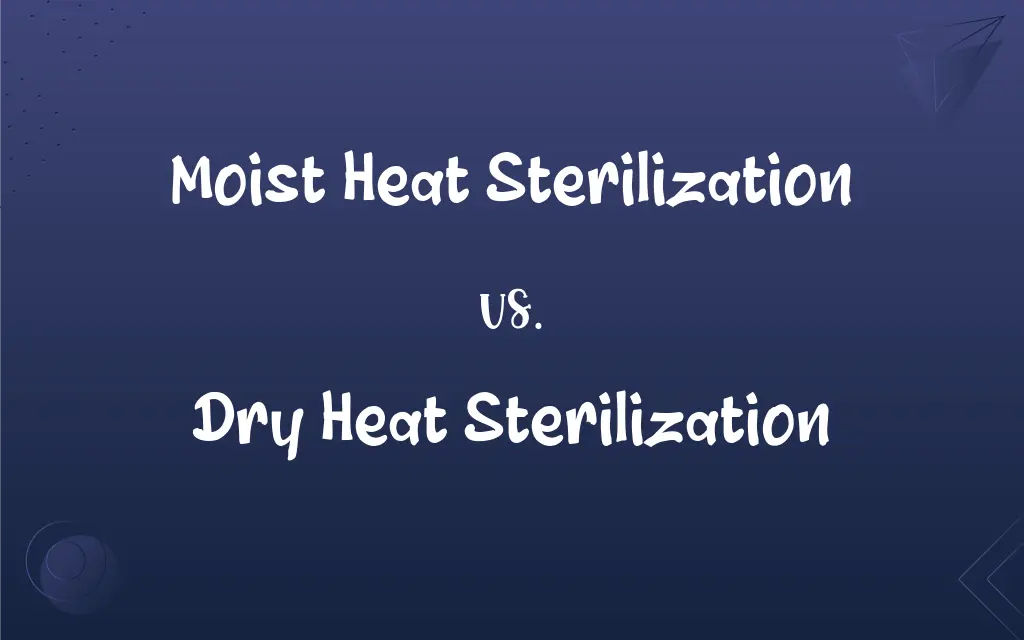Moist Heat Sterilization vs. Dry Heat Sterilization: What's the Difference?
Edited by Janet White || By Harlon Moss || Updated on October 11, 2023
Moist Heat Sterilization involves using water, steam, or other vapor to kill microorganisms. Dry Heat Sterilization employs higher temperatures without moisture to achieve a similar outcome.

Key Differences
Moist Heat Sterilization penetrates and destroys microorganisms, including spores, by using hot steam or water. The elimination of bacteria, viruses, and other pathogens via Moist Heat Sterilization is widely recognized and utilized across diverse industries, particularly in healthcare. The use of steam under pressure, enabling the attainment of high temperatures, is a significant advantage in Moist Heat Sterilization.
Moist Heat Sterilization is renowned for its efficiency and effectiveness in microbial inactivation within a relatively shorter time frame compared to Dry Heat Sterilization. This process employs water or steam, which has an outstanding ability to transfer heat, thereby ensuring rapid thermal death of the microorganisms present. Therefore, Moist Heat Sterilization is often preferred for materials that can tolerate moisture and are heat-stable.
Dry Heat Sterilization, in contrast, necessitates higher temperatures than Moist Heat Sterilization and operates without the presence of any moisture. This technique can be applicable to materials and instruments that may be adversely affected by moisture, ensuring their sterility without compromising structural integrity. Dry Heat Sterilization is potent, but the lack of moisture requires the process to be conducted at higher temperatures and for longer durations.
Dry Heat Sterilization involves methods like hot air ovens and infrared heating to eliminate microorganisms. The absence of moisture in Dry Heat Sterilization means that it does not facilitate the same swift heat transfer that characterizes Moist Heat Sterilization, thereby needing elevated temperatures to ensure thorough sterility. Consequently, Dry Heat Sterilization is selected when materials are moisture-sensitive or inherently dry.
Comparison Chart
Heat Medium
Involves water or steam
Does not involve moisture
ADVERTISEMENT
Temperature and Time
Lower temperatures, shorter times
Higher temperatures, longer times
Material Compatibility
Suitable for moisture-tolerant items
Apt for moisture-sensitive materials
Efficiency
Generally more efficient
May be less efficient
Mechanism
Coagulation of proteins
Oxidation
Moist Heat Sterilization and Dry Heat Sterilization Definitions
Moist Heat Sterilization
This sterilization form can thoroughly eliminate bacteria, spores, and viruses.
Moist heat sterilization eradicated all bacterial spores in the laboratory petri dishes efficiently.
ADVERTISEMENT
Dry Heat Sterilization
Dry heat sterilization is optimal for items that could be damaged by moist heat approaches.
Sensitive electronic medical devices were subjected to dry heat sterilization to prevent water damage.
Moist Heat Sterilization
Moist heat sterilization often requires lower temperatures than its dry heat counterpart.
Moist heat sterilization was utilized at 121°C to ensure the complete sterilization of the surgical tools.
Dry Heat Sterilization
Dry heat sterilization utilizes high temperatures without moisture to destroy microorganisms.
The laboratory employed dry heat sterilization for glassware to ensure the absence of microbial life.
Moist Heat Sterilization
Moist heat sterilization employs steam to eradicate microorganisms.
Autoclaves utilize moist heat sterilization to ensure medical instruments are free from pathogens.
Dry Heat Sterilization
It uses mechanisms like oxidation to inhibit microbial growth and survival.
Dry heat sterilization oxidized the cellular components of bacteria, ensuring the tools were safe to use.
Moist Heat Sterilization
Moist heat sterilization is renowned for its swift and effective microbial elimination.
The canning industry frequently employs moist heat sterilization to preserve the longevity of food items.
Dry Heat Sterilization
This method can involve technologies such as hot air ovens or infrared radiation for sterilization.
The hot air oven was used for dry heat sterilization of the metallic surgical implements.
Moist Heat Sterilization
Moist heat sterilization is particularly suited to materials that won’t be damaged by steam or water.
The rubber tubes were subjected to moist heat sterilization, as they were resilient to the moist conditions.
Dry Heat Sterilization
This sterilization method often requires more extended periods to effectively sterilize items.
The medical instruments underwent three hours of dry heat sterilization to guarantee safety.
FAQs
How does dry heat sterilization work?
It utilizes high temperatures without moisture to eliminate microbial life.
What’s a common tool for moist heat sterilization?
The autoclave is widely used for moist heat sterilization.
Can any material be sterilized using moist heat?
No, only those that are not damaged by heat and moisture.
Is moist heat sterilization suitable for electronics?
No, due to the risk of moisture damage.
Can dry heat sterilization damage materials?
Yes, especially heat-sensitive materials.
What’s a drawback of moist heat sterilization?
Potential damage to moisture- and heat-sensitive materials.
Is moist heat sterilization quicker than dry heat sterilization?
Typically yes, due to better heat transfer properties of steam.
Are there items unsuitable for dry heat sterilization?
Yes, particularly those sensitive to high temperatures.
Which is more energy-efficient: moist heat or dry heat sterilization?
Moist heat sterilization is often more energy-efficient due to shorter cycles.
Can moist heat sterilization eliminate all spores?
Yes, when applied correctly, it is highly effective against spores.
Is dry heat sterilization effective against all types of microorganisms?
It is broadly effective but may require high temperatures and longer times.
Is pressure a factor in dry heat sterilization?
No, pressure is not typically used in dry heat sterilization.
What industries primarily use moist heat sterilization?
Healthcare, food processing, and pharmaceutical industries often utilize it.
Can dry heat sterilization be used for rubber items?
It depends on the rubber’s heat tolerance.
Can dry heat sterilization methods be utilized at home?
It’s less common but possible using techniques like oven heating.
What is moist heat sterilization?
It uses steam or water to destroy microorganisms on items.
Which method generally requires higher temperatures?
Dry heat sterilization often requires higher temperatures than moist heat.
Which sterilization method is better for sterilizing powders?
Dry heat sterilization is typically used for powders and oils.
Why might dry heat sterilization be chosen over moist heat sterilization?
For items sensitive to moisture, dry heat sterilization is preferable.
Is pressure involved in moist heat sterilization?
Yes, it often involves pressurized steam to achieve high temperatures.
About Author
Written by
Harlon MossHarlon is a seasoned quality moderator and accomplished content writer for Difference Wiki. An alumnus of the prestigious University of California, he earned his degree in Computer Science. Leveraging his academic background, Harlon brings a meticulous and informed perspective to his work, ensuring content accuracy and excellence.
Edited by
Janet WhiteJanet White has been an esteemed writer and blogger for Difference Wiki. Holding a Master's degree in Science and Medical Journalism from the prestigious Boston University, she has consistently demonstrated her expertise and passion for her field. When she's not immersed in her work, Janet relishes her time exercising, delving into a good book, and cherishing moments with friends and family.































































